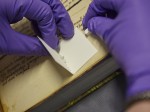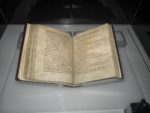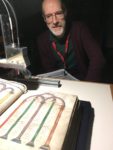 Two years ago, University of York bioarchaeologists used Staedtler Mars Plastic erasers’ characteristic soft, pure white crumbs to collect samples of ultra-thin uterine vellum from 13th century pocket Bibles without damaging the incredibly delicate pages. The microscopic samples collected on the eraser crumbs were then analyzed to determine the animal source of the vellum/parchment and the ages of the animals at time of death. It was a great breakthrough which answered a centuries-old question about the composition of so-called uterine vellum, namely, that it’s neither uterine (made from the skin of aborted or miscarried animals) nor necessarily vellum (made from cow skin) but the product of various young animals whose skin was treated with an unknown technique to create the paper-thin pages.
Two years ago, University of York bioarchaeologists used Staedtler Mars Plastic erasers’ characteristic soft, pure white crumbs to collect samples of ultra-thin uterine vellum from 13th century pocket Bibles without damaging the incredibly delicate pages. The microscopic samples collected on the eraser crumbs were then analyzed to determine the animal source of the vellum/parchment and the ages of the animals at time of death. It was a great breakthrough which answered a centuries-old question about the composition of so-called uterine vellum, namely, that it’s neither uterine (made from the skin of aborted or miscarried animals) nor necessarily vellum (made from cow skin) but the product of various young animals whose skin was treated with an unknown technique to create the paper-thin pages.
 Now the Staedtler Mars eraser has enabled another great leap forward in the study of medieval manuscripts. Researchers from the University of Copenhagen, Trinity College Dublin and the University of York team who did the uterine vellum study have successfully performed DNA and protein analysis on samples from the pages of the York Gospels, an pre-Norman Conquest 11th century codex held at York Minster that is one of very few Anglo-Saxon gospels to have survived the Reformation’s orgy of destruction, and a 12th century Gospel of Luke in the collection of Corpus Christi College, Cambridge.
Now the Staedtler Mars eraser has enabled another great leap forward in the study of medieval manuscripts. Researchers from the University of Copenhagen, Trinity College Dublin and the University of York team who did the uterine vellum study have successfully performed DNA and protein analysis on samples from the pages of the York Gospels, an pre-Norman Conquest 11th century codex held at York Minster that is one of very few Anglo-Saxon gospels to have survived the Reformation’s orgy of destruction, and a 12th century Gospel of Luke in the collection of Corpus Christi College, Cambridge.
 This isn’t the first time DNA has been retrieved from medieval parchment, but as with the extraction of DNA from archaeological remains, the process requires the destruction of some of the material. The Staedtler Mars eraser-based system, which has been dubbed the triboelectric sampling technique, is entirely non-invasive. They don’t even have to deal with the time and expense and making a special trip to take samples from the manuscript. Conservators already use the erasers to keep the pages clean without risking damage, so all they have to do is keep the crumbs instead of brushing them off and then send them in for analysis. It’s cheap, easy, risk-free and the sky’s the limit when it comes to the information that can be derived from the samples.
This isn’t the first time DNA has been retrieved from medieval parchment, but as with the extraction of DNA from archaeological remains, the process requires the destruction of some of the material. The Staedtler Mars eraser-based system, which has been dubbed the triboelectric sampling technique, is entirely non-invasive. They don’t even have to deal with the time and expense and making a special trip to take samples from the manuscript. Conservators already use the erasers to keep the pages clean without risking damage, so all they have to do is keep the crumbs instead of brushing them off and then send them in for analysis. It’s cheap, easy, risk-free and the sky’s the limit when it comes to the information that can be derived from the samples.
The proteins helped identify the animals used to make the book’s pages – mostly cattle in the case of the York Gospels, with some pages made from sheepskin. The DNA also revealed the sex of the animals that provided some of the parchments – most were female. Knowing information like this could, in future, help the researchers understand which livestock populations contributed to parchment making. Or it might even show how bookmakers periodically changed their materials following an outbreak of disease among specific kinds of livestock.
Perhaps more useful, as far as conservators are concerned, is the detection of DNA from bacteria including Saccharopolyspora. This genus is associated with unsightly spots that can develop on old parchment manuscripts. Finding it could alert conservators to the likelihood of the spots appearing on the manuscripts.
Just knowing the type of animal used is useful, says book and paper conservator Emma Nichols at Cambridge University Library. This is because, in their work, conservators often try to match replacement materials with those originally used so that the conservation work is as sympathetic to the document as possible.
The DNA reveals other secrets too. For instance, pages containing oaths for clergy that would have been touched and kissed regularly were associated with higher levels of human DNA.
North Carolina State University. English professor Timothy Stinson, who has been building a database of DNA from medieval manuscripts for the past eight years, calls this novel approach ground-breaking because it gives scholars access to a thousand years’ worth of information about European animal husbandry trapped in manuscripts without sacrificing even a tiny fraction of the precious pages themselves.
The results of the study have been preprinted (meaning not yet peer reviewed) online and can be read free of charge in this pdf.